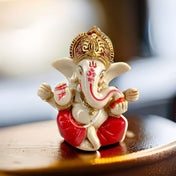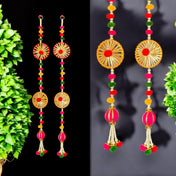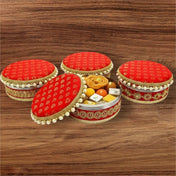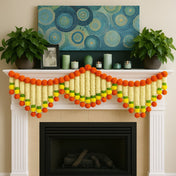Introduction
Shardiya Navratri Puja is one of the most revered Hindu festivals, dedicated to the worship of Goddess Durga, the embodiment of divine feminine power and protection. Celebrated over nine nights, this festival invites devotees to engage deeply with spirituality, devotion, and cultural heritage. Performing Navratri Puja at home offers a sacred opportunity to connect with the divine energy personally and intimately. The spiritual benefits include fostering inner strength, purification of the mind and surroundings, and invoking blessings for prosperity and well-being. Home worship creates a serene space for reflection, gratitude, and renewal.
This article provides A Step-by-Step Guide to Navratri Puja at Home designed to honor traditional practices while embracing authentic navratri decorations that resonate with LoveNspire’s mission. Rooted in cultural richness and devotional sincerity, this guide aims to inspire meaningful celebration within your sacred space. To enhance your home decor during this auspicious time, consider incorporating items like the Happy Durga Puja banner, which can serve as a beautiful addition to your indoor or outdoor temple setup.
Understanding the Essence of the Day of Navratri
Navratri is a festival that holds deep significance, celebrated over nine sacred nights. Each night is dedicated to different forms of divine feminine energy, symbolizing the victory of good over evil and inviting spiritual renewal. During this time, we pay homage to various manifestations of Goddess Durga, who embodies qualities essential to our human experience.
The Idol of Goddess Durga and the Divine Family
While the primary focus of worship during Navratri is on Goddess Durga, it also extends to her divine family members:
- Goddess Lakshmi: The embodiment of wealth and prosperity
- Goddess Saraswati: The bestower of wisdom and learning
- Lord Kartikeya: The symbol of valor and protection
These deities together represent a holistic approach to seeking blessings in various aspects of life during this festival. Many households display idols like Lakshmi, Saraswati, and Durga as a way to invite these positive energies into their homes.
Unique Nine Days Themes of Navratri
The themes central to this festival revolve around:
- Protection from negative influences
- Wisdom for gaining clarity and insight
- Prosperity in both material and spiritual realms
- Spiritual growth through acts of devotion and self-discipline
By engaging with these energies during Navratri, we cultivate a balanced and empowered existence that aligns with the cosmic rhythms around us. For example, on Navratri Day 2, we specifically honor Maa Brahmacharini, highlighting her embodiment of penance, devotion, and the unwavering pursuit of spiritual goals.
Preparing for and the Guide to Perform Navratri Puja at Home

Creating a sacred atmosphere is essential for Navratri preparation and elevates the spiritual experience of the festival.
Selecting the Puja Space for Navratri 2025
- Choose a quiet, clutter-free corner or room in your home where the altar can be set up.
- The space should invite calmness and reverence, ideally facing east or north to harness auspicious energies.
- Designate this area solely for worship throughout Navratri to maintain its sanctity.
Cleanliness and Purity of the Place for Performing the Navratri Puja
- Clean the entire puja area thoroughly before beginning any rituals. This not only honors tradition but also symbolizes clearing negative energies.
- Purity extends beyond physical cleanliness—washing hands and feet before entering the puja space aligns the body with spiritual intent.
Decorative Elements to Perform the Puja Thus Enhancing Devotion
- Using marigold flowers brings vibrant color and fragrance, believed to attract positive vibrations and divine blessings. These can be used in garlands or decorative pieces around your home.
- Intricate rangoli designs at the entrance or around the altar invoke festive joy and welcome Goddess Durga’s presence.
- Hanging torans (decorative garlands) made of mango leaves or flowers adorn doorways, symbolizing prosperity and protection. Consider incorporating artificial marigold flowers jumbo jhoomar for such decorations.
- Lighting diyas (oil lamps) adds warmth and illumination, dispelling darkness and inviting auspiciousness.
Incorporating LoveNspire’s Ethnic Décor as Part of the Navratri Puja 
LoveNspire offers an exquisite range of handcrafted ethnic décor to enrich your puja setup. Their products blend age-old artistry with contemporary elegance—perfect for authentic Navratri decoration ideas. Consider:
- Hand-painted terracotta lamps that radiate traditional charm.
- Embroidered textiles for altar cloths that add texture and richness.
- Brass puja thalis adorned with intricate motifs, enhancing ritual aesthetics.
Each decorative choice deepens connection to culture and tradition while transforming your home into a vibrant sanctuary for Navratri worship.
Step 1: Invoking the Divine Presence through Ghatasthapana (Kalash Sthapana) Ritual

The Ghatasthapana ritual, also known as Kalash Sthapana, marks the sacred beginning of Navratri Puja at home. This ritual invites Goddess Durga's divine energy to reside within the Kalash, symbolizing the universe and the source of life.
Preparing the Kalash involves these precise steps:
- Select a clay pot (Kalash), representing the womb of creation.
- Place layers of clean soil inside the pot, signifying Mother Earth’s nurturing aspect.
- Sow barley seeds over the soil; these sprout during the festival, symbolizing growth, fertility, and renewal.
Filling and adorning the Kalash:
- Fill the pot with holy water drawn from sacred rivers or purified at home, embodying life’s essence.
- Add auspicious offerings such as betel nut, coins for prosperity, turmeric for purity, and sandalwood paste representing spiritual sanctity.
Final adornments place the Kalash in its full glory:
- Arrange mango or Ashoka leaves around the mouth of the pot; these leaves are believed to attract positive vibrations and divine blessings.
- Place a coconut, wrapped in red cloth, atop the leaves—this symbolizes fertility, protection, and auspiciousness.
Each element within this ritual carries profound symbolism tied directly to Goddess Durga’s power:
The clay pot holds cosmic energy;
The soil and barley represent life’s growth cycles;
The offerings invoke prosperity and purity;
The leaves and coconut serve as a bridge connecting earthly devotion with celestial grace.
This meticulous act of Ghatasthapana sets a powerful spiritual foundation, inviting devotees to connect deeply with the goddess’s protective and nurturing presence throughout Navratri.
Step 2: Daily Puja Rituals During Navratri for Best Puja Experience 
Performing the daily Navratri puja steps with devotion creates a profound connection to Goddess Durga’s divine presence. Begin with meditation and invocation, chanting traditional mantras such as the Durga Stotra or Devi Kavacham to invoke her protective and benevolent energy. These sacred chants align the mind and spirit for worship.
Offerings form an essential part of the ritual:
- Pushpanjali (flower offering): Present fresh flowers like marigold, hibiscus, or jasmine with folded hands, symbolizing surrender and love.
- Dhoop (incense): Light incense sticks to purify the atmosphere and invite auspicious vibrations.
- Deepam (lamp lighting): Illuminate the altar with oil or ghee lamps, representing knowledge dispelling darkness.
Food offerings (naivedya) express gratitude and reverence:
- Sweets such as laddoos or kheer invoke sweetness in life.
- Seasonal fruits (rituphala) honor nature’s bounty, connecting worshippers with cosmic cycles.
- Narikela (coconut) signifies purity and fertility, often broken as part of the ritual.
Traditional sacred items enhance spiritual symbolism:
- Roli (vermilion) and haridra (turmeric) are applied on the deity’s forehead or offered in small amounts symbolizing protection and auspiciousness.
- Betel leaves accompany offerings, known for their purifying properties and cultural significance.
LoveNspire’s elegant ethnic décor pieces can beautifully complement this setup, enriching the puja space with authentic tradition and contemporary style.
Step 3: Symbolic Acts for the Invocation of Goddess in the Daily Worship 
Daily worship during Shardiya Navratri involves deeply symbolic acts that honor Goddess Durga with reverence and devotion. These rituals embody purification, respect, and beautification of the divine presence.
1. Padya Prakshalana (Washing Feet Ritual)
Washing the feet of the deity or the symbolic representation of Goddess Durga is a sacred act called padya prakshalana. This ritual signifies purification and humility, cleansing not only the physical form but also creating an atmosphere of spiritual purity. It reflects the devotee’s respect and readiness to receive divine blessings.
2. Achamana (Offering Water for Internal Purification)
The ritual of achamana involves offering water for internal purification. Devotees sip water to cleanse their body and mind, aligning themselves with the sacredness of the puja. This practice bridges physical cleanliness with spiritual sanctity, preparing participants to engage fully in worship.
3. Vastra and Abhushana (Adorning the Deity)
Dressing the deity in fresh clothes (vastra) and adorning with ornaments (abhushana) symbolizes care and devotion. Selecting vibrant fabrics and exquisite jewelry reflects both aesthetic beauty and deep reverence. LoveNspire’s ethnic décor items can enhance this practice by providing authentic textiles and handcrafted embellishments that celebrate Indian craftsmanship.
4. Application of Chandan and Roli (Sandalwood Paste & Kumkum)
Applying sandalwood paste (chandan) on the deity cools and soothes, symbolizing purity and tranquility. The vibrant red roli (kumkum) mark represents auspiciousness and energy. These sacred markings are essential to daily worship, visually expressing devotion while invoking divine blessings.
Each act within this step transforms simple gestures into profound expressions of love, connecting devotees intimately with Goddess Durga’s power and grace.
Step 4: Circumambulation & Forgiveness Rituals are Significant Rituals During Navratri 
The pradakshina ritual is an intimate expression of devotion performed by walking clockwise around the deity’s altar. This sacred act symbolizes the devotee’s reverence and submission to Goddess Durga. During Navratri Puja at home, devotees carry flowers or incense sticks as they circumambulate, gently circling the Kalash or idol. Each step taken in this movement represents surrendering ego and centering one’s focus on divine energy.
Key elements of the pradakshina ritual include:
- Holding fragrant flowers or burning incense (dhoop) to purify the surroundings.
- Moving steadily with mindful awareness, embracing humility.
- Completing an odd number of rounds, commonly three or seven times, to honor auspiciousness.
Following the physical act of devotion comes the spiritual cleansing through kshamapan, a prayer for forgiveness. The kshamapan mantra is chanted softly to seek pardon for any inadvertent mistakes or lapses during worship. This practice nurtures a sincere heart and ensures that purity of intention remains intact throughout the festival.
“O Lord, forgive me if I have committed any errors knowingly or unknowingly during this sacred puja. May my mind and soul be cleansed and aligned with divine grace.”
Incorporating these rituals into your daily Navratri Puja deepens the connection with Goddess Durga while maintaining sanctity in your home altar space. The harmony between physical devotion and heartfelt repentance enriches this celebration, fostering spiritual growth alongside cultural tradition.
Special Ceremonies During Navratri Having Perfect Connection with the Divine Power 
Kanya Pujan: Honoring the Divine Feminine
The Kanya Pujan ceremony holds a revered place in Navratri celebrations, traditionally observed on the eighth or ninth day. This ritual honors young girls, usually between the ages of two and ten, as living embodiments of Shakti — the divine feminine energy represented by Goddess Durga. By inviting these children into the puja space and offering them respect, food, and gifts, devotees symbolically acknowledge purity, innocence, and the nurturing power of the goddess.
Significance and Procedure of Kanya Pujan:
- Selection: Choose young girls with clean attire to participate in the ceremony.
- Invocation: Begin by invoking Goddess Durga’s presence within each child through mantras and gentle prayers.
- Offerings: Present traditional items such as vermilion (kumkum), turmeric, flowers, sweets, and fruits.
- Blessing: Touch their feet as a mark of reverence; this act symbolizes humility and devotion.
- Gifts: Distribute tokens or gifts to honor their role as manifestations of divine energy. For those looking for unique ideas on Navratri gifting, there are numerous options available that can add a special touch to this ritual.
This ceremony strengthens bonds within family and community while fostering appreciation for feminine strength and grace.
Vijayadashami: The Triumph of Good Over Evil
The festival culminates on Vijayadashami, also known as Dussehra, celebrating the triumph of good over evil. Devotees perform concluding prayers seeking blessings for courage and righteousness. Festivities may include lighting lamps, singing devotional songs, and sharing festive meals—all echoing themes of victory, renewal, and spiritual upliftment.
Essential Puja Items & Gifts from LoveNspire to Conclude the Puja with Perfection

Creating a sacred puja space requires the right Navratri pooja items, each representing devotion and reverence. LoveNspire’s curated collections bring together traditional elements crafted with care, elevating your worship experience.
Must-have puja essentials include:
- Kalash Sets: Beautifully handcrafted clay or metal pots, accompanied by mango leaves and coconuts, embodying auspiciousness and divine energy.
- Traditional Incense Holders: Artisanal designs that hold fragrant dhoop sticks, filling the puja area with sacred aromas.
- Diya Lamps: Ethnic brass or terracotta diyas, perfect for lighting during aarti, symbolizing enlightenment and purity. For a modern twist, consider our candle holder t-light holders which also serve as excellent Diwali diya holders.
Celebrating Navratri extends beyond rituals to sharing blessings through meaningful gifts. LoveNspire offers:
- Ethnic Jewelry: Delicate handcrafted pieces inspired by Indian heritage, ideal for gifting to loved ones during this festive season.
- Home Décor: Unique items such as embroidered torans, intricately painted idols, and vibrant rangoli stencils that reflect the festival’s spirit.
Moreover, our personalized Diwali gift boxes and Navratri gift hampers are perfect for spreading joy among family and friends during this festive season. LoveNspire stands as a bridge between tradition and modernity by supporting cultural heritage through authentic handmade products. These offerings not only enhance your devotional setup but also nurture a deeper connection to the rich tapestry of Indian festivals. Each item carries stories of craftsmanship and devotion, making your Navratri celebrations truly memorable. Experience the divine celebration of Navratri with LoveNspire's exclusive Navratri collection, shipped directly from Michigan, USA.
Observing Fasts & Spiritual Discipline During Navratri
Fasting during Navratri holds deep spiritual significance, serving as a practice of physical cleansing and mental focus to enhance devotion. The discipline reflects dedication to Goddess Durga, fostering inner strength and clarity over the nine sacred days.
Key aspects of Navratri fasting include:
- Types of fasting: Many devotees choose complete abstinence from grains and non-vegetarian foods, while some opt for partial fasts—consuming fruits, milk, nuts, and specific flours like buckwheat (kuttu) or water chestnut (singhara).
- Energy maintenance: To sustain vitality during fasts, incorporate nutrient-rich foods such as soaked almonds, coconut water, fresh fruit smoothies, and light dairy preparations like kheer made with allowed ingredients.
- Hydration: Drinking ample water and herbal teas helps maintain balance and aids detoxification throughout the day.
- Mindfulness practices: Fasting is not only about dietary restrictions but also cultivating awareness, patience, and gratitude. Regular meditation sessions, chanting Durga mantras, or reading sacred texts deepen the spiritual experience beyond physical rituals.
- Avoiding distractions: Limiting exposure to negative thoughts or activities preserves the sanctity of the fast and aligns the mind with devotional energy.
Engaging in these fasting tips heightens receptivity to divine blessings while nurturing a tranquil state of being essential for meaningful participation in Navratri puja at home.
Conclusion
Welcoming Navratri blessings at home allows us to connect with our heritage and find inner peace. This A Step-by-Step Guide to Navratri Puja at Home shows us how tradition and heartfelt devotion can come together, bringing spiritual harmony into our daily lives. Here are some key takeaways from the guide:
- Approach each ritual with sincere love, allowing the divine energy of Goddess Durga and her family to inspire growth.
- Create sacred spaces that reflect authenticity and warmth, enriched by cultural artistry and thoughtful details.
- Invite the spirit of community by sharing these moments and stories with loved ones, strengthening bonds through meaningful celebration.
LoveNspire’s mission resonates deeply here—bridging diverse cultural expressions to enrich lives. Through these cherished practices, each home becomes a sanctuary of faith, beauty, and timeless tradition. Celebrate Navratri not just as a festival but as an enduring journey of devotion and cultural pride.




















